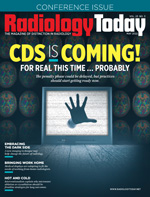 AI Insights: Toward Greater Efficiency
AI Insights: Toward Greater Efficiency
By Hila Goldman-Aslan, LLM, LLB, BBA
Radiology Today
Vol. 23 No. 3 P. 5
AI software shows promise for ultrasound workflow.
AI-based software has become prevalent in all health care modalities, reducing the subjectivity and variability associated with human interpretation and supporting clinical decision making in various health care environments. Previously hesitant health care professionals around the globe have become increasingly accepting of AI-based software analysis tools. The outbreak of the COVID pandemic has accelerated the trend, as hospitals have experienced extreme resource shortages.
One area of rising need is ultrasound solutions. The ultrasound market, expected to be worth $7 billion by 2026, is rapidly growing and expanding into new clinical settings. AI is driving this growth.
For ultrasound users with various levels of experience and working in different environments, such as the echo lab or point-of-care setting, AI-based software allows for a quick, objective, and accurate analysis of patient scans. Today, ultrasound image analysis is often performed manually or visually, making this process subjective, time consuming, error prone, and highly dependent on users' experience. As a result, standard analysis may lead to diagnostic errors and redundant exams. AI-based software can automate these processes.
Moreover, the time-consuming and cumbersome image evaluation and analysis process often prevents clinicians from recording results in their final reports. This can negatively impact patients, who may be missing pivotal clinical information from their records. It can also affect health care institutions, whose failure to record clinical results in final reports can prevent reimbursement. But, with certain AI solutions, clinicians can record and reimburse exams with ease, improving the hospital’s return on investment.
AI Assists Clinicians
AI-based systems incorporate a deep neural network to perform both automated view recognition and analysis of ultrasound scans. They learn from hundreds of thousands of images, annotated by human experts, to produce accurate results and standardized measurements. The AI solutions do not replace the experts but, rather, support their decision-making processes by providing an objective analysis, detecting abnormalities that may be difficult to find manually.
Utilizing AI-based ultrasound software for ongoing patient care enables automation for the entire image analysis workflow. Using the same technology for patient image evaluation and follow-up limits confusion and inaccuracies among scans. The accessibility of select AI-based solutions to “run” on everyday tools and integrate directly into health care workers’ workflow can allow for a simple merge onto any device, in any facility. In addition, by automating the image analysis processes, AI-based solutions allow for a larger scale of data processing and additional time for patient care.
In the echo lab, for example, AI-based software is present in two sections of the ultrasound process: the clips selection and the analysis process. Upon acquisition of 60 to 80 echo images per scan, the AI software selects the optimal clips relevant for analysis, removing subjectivity and allowing the system to automatically receive key indication analysis on images, regardless of the ultrasound device. AI improves the workflow by permitting an enhanced utilization of automatic key measurements like strain analysis.
The pandemic has opened the door to an increased use of AI-based solutions, creating a safer environment for both physicians and patients. In the realm of ultrasound devices, AI can have a crucial impact on the analysis of images, providing for an objective, automated, and accurate analysis of scans. Recent studies highlight the importance of monitoring the hearts of COVID-19–positive patients, both during and after infection, particularly within the first year of infection. AI-based solutions can help ultrasound users quickly identify and monitor COVID-19 patients with cardiac symptoms, reducing bottlenecks and the medical staff’s risk of infection by shortening scan times, thus reducing the amount of time technologists spend in proximity to COVID-positive patients.
In addition, the American Society for Echocardiography and the European Association for Cardiovascular Imaging have recommended assessing the global function of both the right and left ventricles for all suspected/confirmed COVID-positive patients. Additional studies have shown that the ultrasound assessment of the heart’s right ventricle size and function is a key indicator of cardiac dysfunction that may be caused by pulmonary embolism, pulmonary hypertension, or potential heart failure, all of which have been linked to increased mortality in COVID-19 patients.
As the pandemic has been a substantial pilot for showcasing and increasing medical AI awareness, we’ve seen how AI solutions can support physicians during the diagnosis and clinical decision-making process. Within the realm of ultrasound solutions, AI can facilitate improved patient care and outcomes by aiding scan analysis.
— Hila Goldman-Aslan, LLM, LLB, BBA, is the CEO and cofounder of DiA Imaging Analysis and an expert in AI for ultrasound solutions. She holds a master’s degree in law from Tel Aviv University in Israel, specializing in commercial law, as well as dual bachelor's degrees in law and business administration.

